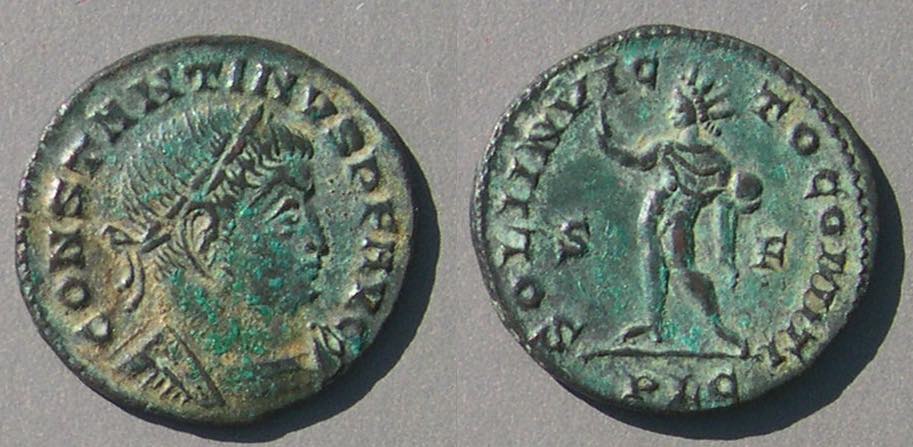
How can I find out more?
Ancient coins (unlike modern coins) are very closely related to history. Most collectors feel that by reading about history they are learning interesting things about coins as well. For example, when you read that Constantine the Great (Roman emperor from 307 to 337 AD) was the first emperor to promote Christianity, you might wish to buy a coin he minted. You can buy a clear copper piece the size of a cent with his portrait for $10, and get it in even better condition for $30 or less.
I meant, how can I find out more about the coins?
The web is a good place to start. When you finish this page, look at sites listed here. It is wonderful if you can find a collector or a dealer who will help you get started, but many collectors do not know any other local collectors and continue to collect alone. They begin simply by buying a coin or two.
There are sites on the web where collectors gather to show and discuss ancient coins. I'll give the links below.
Libraries often have a few beginners books specifically about ancient coins. Big public libraries and libraries at universities may have many books about ancient coins--there are hundreds! Remember, in Europe archaeology and history of the ancient world is a big deal--much bigger than here. Over there you can take university courses in ancient coins. And lots of books have been written in English about them.
Will you recommend some books?
I put my book recommendations on another page. (It links back to here if you go there.)
Where can I buy books on ancient coins?
When I want an ancient-coin book, I search vcoins.com and the usual book sites like Amazon and ABE for it, or even search eBay.
I've never been to a coin show.
I love coin shows and I recommend them. There are so many coins to see and so much to learn about what is available. Shows usually occur in major cities. But, shows are not a particularly cheap place to buy ancient coins. You can do fine just buying on the web.
How about buying on the web?
Most collectors buy regularly on the web. Many collectors participate in ancient-coin auctions on eBay. However, before you buy from eBay, read this. It has many very important things to say that you will want to know. There are many large and small dealers with fixed-price sites. I can strongly recommend looking at the ancient coin mall, vcoins.com. You can use the search engine in the upper right to search all the mall dealers at once! Here is a list of most active ancient-coin dealers on the web.
Can I buy a coin of Alexander the Great?
A silver coin of Alexander the Great.
Certainly! One of the nice things about ancients is that the famous rulers who ruled a long time minted lots of coins. Large (bigger than a quarter, and twice as thick) silver coins of Alexander are very available today. By the way, the portrait is of Hercules, not Alexander, although these coins are often said to have his features.
This one might cost $150-$250.
I've heard of Julius Caesar and Nero. Can I buy coins of theirs?
Yes. Large portrait coins of Nero minted in Egypt are available in fine condition for $70 or less. Here is one of them -- worn, but cheap. It is a base silver tetradrachm.

Nero / Head of Alexandria (the city in Egypt where it was minted)
Much better portraits are also available, but will cost more.

Portrait pieces of Julius Caesar are expensive (because of very high demand; they are not very rare), but he also minted attractive silver coins without his portrait that say "CAESAR" boldly, and those can be bought in very fine condition for $400-$800, or less in lesser condition.
I don't want to spend $400!
Many collectors don't buy expensive coins like that. There are many very interesting emperors who minted attractive coins that have been found in hoards so large that even high-grade pieces are not expensive.
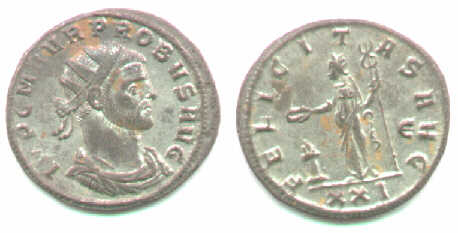
Coins as attractive as this Roman coin of emperor Probus might be found for $30-$60 on eBay or vcoins or at many auctions. (See this page of places to buy ancient coins.)
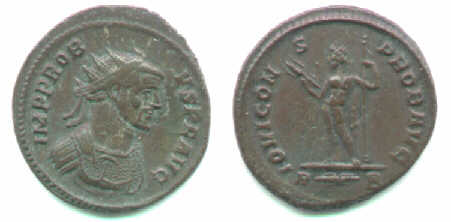
This lower-grade Probus might sell on eBay for $20-$35.
Inexpensive coins would, of course, be copper or silver, not gold.
What can I buy for $25?
A very wide variety of excellent ancient coins sell for $25. You can buy, in very nice grade, a nickle-sized base silver coin of any of a dozen third century AD emperors (200 - 300 AD), or a copper coin the size of a quarter from any of a half dozen early fourth century AD emperors, or a dime sized copper coins of any of a dozen fourth century (300 - 400 AD) rulers. You can buy attractive silver coins in worn but legible condition of most of the second century AD (100 -200 AD) emperors. You can buy attractive but worn Greek copper coins from dozens (really!) of different mint cities. Also available are many other types issued by rulers and ancient kingdoms too numerous to mention.
It's pretty confusing!
Anything new is confusing at first. Perhaps that is why most collectors buy Roman imperial coins -- the straightforward run of emperors is easy to organize and understand. But many branch out into other areas, for example Greek, Jewish, Parthian or pre-Roman British after they get started and know a bit more.
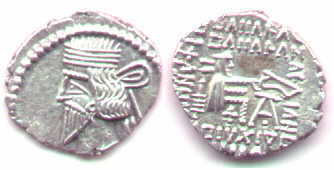
Silver. 20 mm. A Parthian coin of Vologases III, 105-147 AD. The Parthians ruled in the region of modern Iran and Iraq.
What about older coins -- coins from the time of Christ?
There are lots of them available, too. Roman coins from the period of the emperors Augustus and Tiberius are popular. They ruled from 27 BC to 37 AD when Christ preached and died. The Roman Republic minted silver coins for over two hundred years before Christ, and most types from the first certurn BC are available for less than $100 in nice grade and much less if quite worn.
Coins were invented about 600 BC (2600 years ago!) and caught on quickly. Greek coins from before 300 BC are very available and some are among the most beautiful coins ever minted.

A silver coin from the city of Tarentum (a.k.a. Taras) in Southern Italy with an image of the founding myth on the reverse--a dolphin rescuing the founder from a shipwreck.
Big silver coins in very nice condition will cost a lot, say $200 or more, but interesting copper and smaller Greek silver coins cost much less, down to $10 or $20 or $30 if worn and not unusual.
Most collectors prefer big coins, but there are many tiny Greek coins (called "fractions") of very small silver denominations that cost maybe $30 or less!
 This tiny coin is from Kolophia, Io
This tiny coin is from Kolophia, Io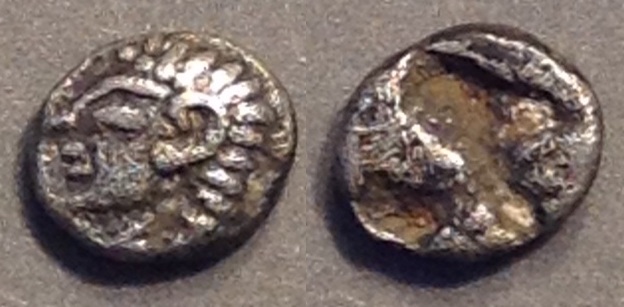 nia (in modern Turkey). It was struck in the late 6th century BC. That is really old! It is only 6 mm and 0.36 grams. You can see that it is tiny compared to a US cent.
nia (in modern Turkey). It was struck in the late 6th century BC. That is really old! It is only 6 mm and 0.36 grams. You can see that it is tiny compared to a US cent.
The type is an archaic head of Apollo (like you see on Greek statues in museums) left. The reverse has no design, only an incuse from the punch die.
This is a large (32 mm) Byzantine copper coin of Basil II ("the Bulgar Slayer") and Constantine VIII, AD 976 - 1028. Similar coins sell for $10-$40. It has a facing bust of Christ and says "Jesus Christ, King of Kings" on the reverse (in Greek).
The Byzantine empire is the name of the eastern Roman empire after the west fell (The fall is traditionally dated to 476 AD). Large Byzantine copper coins are plentiful and even cheaper than most ancient coins (but some would call them ugly).
Yes. Many emperors issued coins portraying their wives, some of whom were powerful in their own right.
Julia Domna (d. AD 217) is one. IVLIA PIA FELIX AVG
VENVS GENETRIX, Venus seated left
Julia Maesa, Herennia Etruscilla and many others appear too.
Grading is not the same problem it is with modern U.S. coins. Ancient coins were struck by hand on irregular flans from dies engraved by hand. No one expects ancient coins to be fully described by a single "grade," so grades play less of a role. At a coin show, very few ancient coins will be graded at all. Look at the coin's image and judge each coin on its own merits, which may include style, depth of strike, centering, patina, color, size of flan, and surface condition in addition to a judgement about wear. The best question to answer is "Do you like it?"
My thoughts about grading (which are especially relevant if you come from collecting US coins) are here.
Doug Smith has an informative and well-illustrated website about grading ancient coins and the factors that affect condition and value. The Calgary Coin Gallery also has a good site on grading. Just be aware that sellers on eBay often exaggerate the quality of their coins, which may not live up to the professional standards described by these two sites.
Can I see some typical coins, with typical prices?
Sure. Go to http://www.vcoins.com/en/coins/Ancient.aspx and "search" for any key word you like, or just see what has been offered in the last week. It is a great way to find out retail values.
Another way is to go to the ancient coin section of eBay.com ("coins, ancient") and note a few coins that interest you. The current prices you see are of no relevance. But, bookmark them and go back after they close and you will see what coins sell for, if they sell at all. Many many eBay coins do not sell because the opening level is too high. The prices on eBay mean nothing until after the auction has closed and the coin actually has several bids. Many buyers bid only in the last few seconds and prices may double, triple, or quadruple at the last instant. Also, many coins have opening prices that are higher than retail and they will not sell except to an ignorant sucker.
There is a website, wildwinds.com, that lists and illustrates coins that have sold on the web (many on eBay). You can find out what coins look like and what they cost at a web auction with this excellent site.
Do I have to worry about fakes?
Yes, if you buy on eBay. eBay has very many fakes and abused coins. But you don't have to worry about fakes if you deal with a professional ancient coin dealer. They are knowledgeable and separate out any fakes they happen to run across. Furthermore, they guarantee what they sell.
My answer to whether fakes are a problem has changed from "no" to "yes" since eBay became popular. When coins are bought from coin dealers at a real store, few fakes are found. It is extremely rare to see fakes offered at the websites of the major US ancient coin dealers. Major dealers, and dealers with a physical store, have a reputation to uphold and are careful with what they sell. But, everything has changed with web selling. Now many eBay sellers are touting obvious fakes and getting away with it. eBay has a policy that their site is "just a venue" and they apparently take almost no action to cut off sellers of fakes. And, even if they wanted to, it would be hard, since anyone anywhere can log in with a new user name and start selling fakes.
If you are going to buy ancient coins, read this about avoiding fakes.
Always remember: Tomorrow another thousand ancient coins, most genuine, will be offered on eBay and vcoins.com, so you don't need to bid on a doubtful coin today.
Can you give me some advice about buying ancient coins and not paying too much?
Yes. Here is a link to page of advice about buying ancient coins
What about buying at major-firm auctions?
Here is a link to a page about coin auctions.
I have ancient coins and I wonder what they are worth and how to sell them. Can you help?
Yes, some. See a page about selling ancient coins.
What about coins as an investment?
I do not recommend ancient coins as a way to make money. However, they pay off very well in other ways. Here is a page about investing in coins.
I'm getting interested. Is there a forum on ancient coins that I can join?
Yes. Many beginners post at "Coin Community" in their ancient-coin section:
http://www.coincommunity.com/forum/forum.asp?FORUM_ID=51
Many (some also use Coin Community) post at "Coin Talk" in their ancient section:
https://www.cointalk.com/forums/ancients/
Forum ancient coins has an active forum, mostly for experienced collectors, but beginners are welcome:
http://www.forumancientcoins.com/board/index.php
A forum begun in 2022, Numis Forums, is much like CoinTalk. (This is the forum I frequent most, although I visit the other, too.)
https://www.numisforums.com/
Late Roman bronze coins are among the least expensive ancient coins, but are quite interesting. There is a disussion board devoted to them:
http://www.lateromanbronzecoinforum.com/index.php
Can you recommend other sites on ancient coins?
I have written an annotated list of my favorite educational sites on Roman coins.
Are there sites on how to clean ancient coins?
Yes, but I strongly recommend you do not try to clean ancient silver coins that have toned dark, or copper coins that show many details under smooth dark or green surfaces. Collectors love untouched and uncleaned old coins, so you risk lowering the value a huge amount if you make a copper coin look like copper, or make a silver coin look bright and shiny. However, if you are buying very cheap low-grade coins in bulk (hundreds at a time) you may need to clean them. But, I strongly encourage you not to clean any coins you have inherited or gotten from a friend. Leave cleaning for the experts!
Where can I buy large batches of cheap uncleaned coins? I'd like to get them before they get to eBay.
I do not recommend buying uncleaned coins. But, I get this question a lot so I am answering it here (Rather than every week via separate e-mails). If you are already buying lousy unidentified coins, I can recommend the best book for learning to identify them.
I have some ancient coins. How should I store them?
Every ancient coin collector I know wants to be able to touch his/her coins. Unlike U.S. coins, they can be handled. Most collectors use either paper 2x2 envelopes or non-PVC "flips". If your home is very very dry (where I live it is dry like a desert), PVC flips will not cause a problem for many years, if ever. But the "soft" PVC flips will interact with water in the air and form acid which eats coins and leaves a horrible green deposit. People who live in humid places really have to worry about that. But non-PVC flips are very cheap (compared to coins) and worth it. You can put identification in one side and the coin in the other, and slip out the coin (carefully, since the edge of non-PVC flips can be sharp enough to scratch a coin) when you want to handle it. You can buy them lots of places, including vcoins.com (search for "flips"). There are at least two brands and you can get good flips from other dealers, too. But, if it doesn't mention "Safe" or "Safety," don't buy them.
With only a limited number of high-quality coins, some people put them in the splendid "Abafil" cases (available at coin.com or occasionally used on eBay) and never put them in flips at all. But most put coins in the bank in non-PVC flips which go into boxes designed for holding 2x2's. Some of my friends have a small Abafil case for taking a few coins home from the bank.
What about slabs?
Most experienced ancient-coin collectors dislike slabs. They add to the cost, add a huge amount of volume, and prohibit you from handling the coins. Most serious collectors just buy genuine coins in flips and enjoy handling them. If they want a coin that happens to come slabbed at the right price, they will buy it and crack it out.
Do many people collect ancient coins?
In the U.S., collectors are few and far between. There may be 10,000 or so, with a couple thousand very serious collectors. But, in Europe, every coin shop has some ancients and collectors are more common. But, the web has made the world much smaller and you don't have to collect alone, even if you are many miles from anyone else who collects. My five best collecting friends are in five different states, and we correspond all the time! We have great fun enjoying our hobby.
Thank you for the introduction!
You're welcome!
-- Augustus (If you want, you may write me at  )
)
Return to the top of this page (page 3) of Ancient Roman and Greek Coins.
Return to the beginning of page 1 of Ancient Roman and Greek Coins.
Return to the beginning of page 2 of Ancient Roman and Greek Coins.
Go to a page about legends on Roman coins.
Go to the overall main page of my site.
First posted in 1997. Revised many times, most recently June 5, 2023.